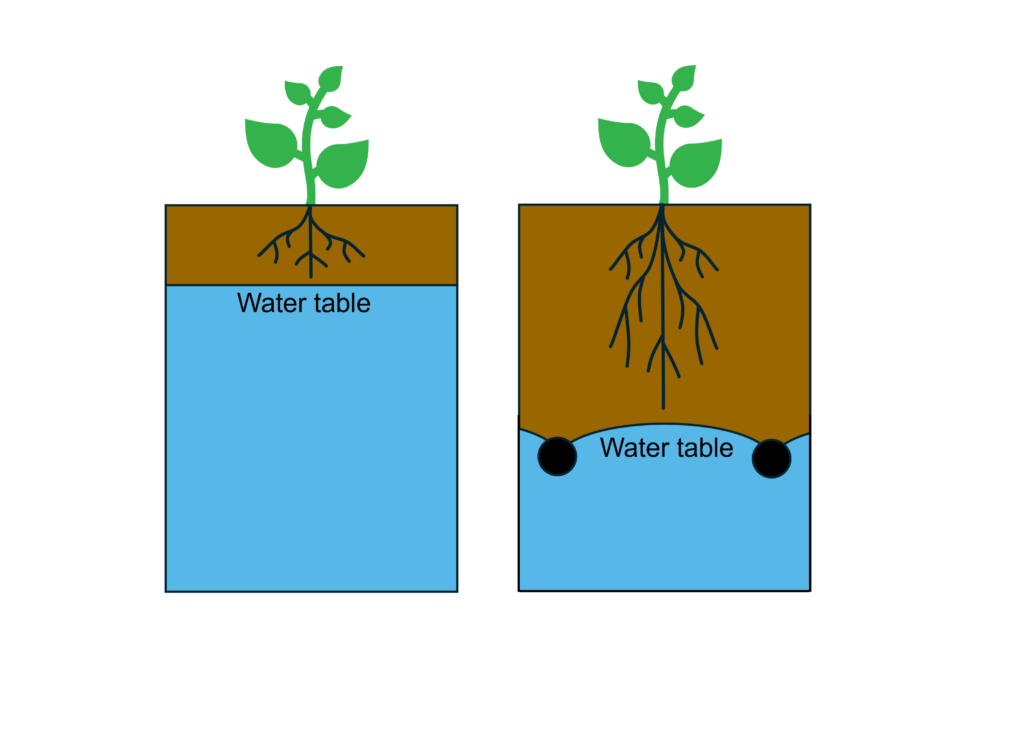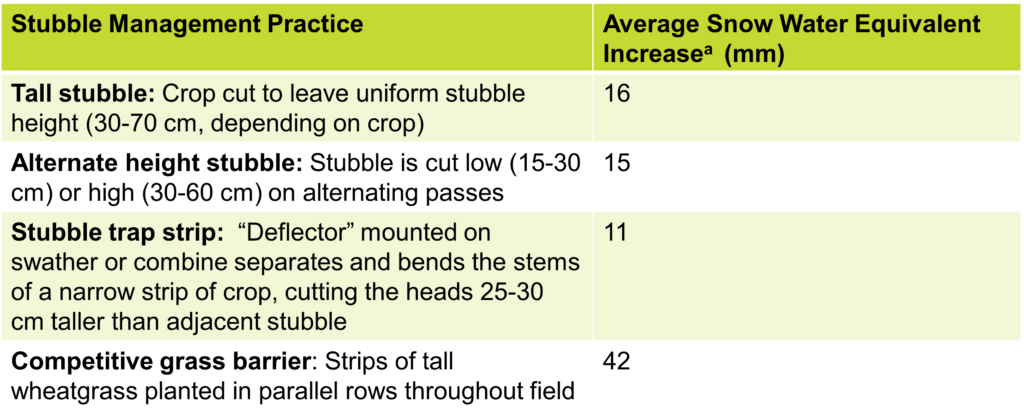Section Title
Managing Extremes of Moisture Part 3: Field Activities
- Whole Farm
This is Part 3 in a three-part series on managing extremes of moisture. Part 1 focuses on soil properties and definitions and Part 2 focuses on crop selection, pests and fertility. If you haven’t already, we recommend reading Parts 1 and 2 first.
As discussed in Part 2 of this series, crop selection can be an important consideration when managing a resilient cropping system. In addition to crop selection, field activities such as tillage, residue management and drainage are also important to consider.
Field Activity - Seeding and In-Season
It is important to consider how the timing and nature of field activities at seeding and throughout the growing season can help or hinder moisture management. For example:
- Seeding date: Data from Manitoba Agricultural Services Corporation (MASC) shows that earlier seeding typically results in higher yields. Several factors contribute to this yield increase, including the crop’s ability to better utilize early spring moisture as well as reduced heat damage at flowering. More information on the benefits and risks of early seeding can be found here.
- Seeding equipment: Just as tillage practices can have a significant effect on soil water (see section on tillage below), the choice of high vs low disturbance openers can have an effect.
- Rutting and compaction: Moist soils that are near field capacity are the most susceptible to compaction. Tillage, wheel traffic, and field operations when soil is most vulnerable can all result in compaction. Under wet conditions, compaction causes reduced water infiltration, reduced movement of water through the soil and reduced aeration. Under dry conditions, moderately compacted soil can actually improve seed to soil contact and result in higher yields. More information on mitigating and preventing soil compaction can be found in the Manitoba Agriculture Soil Fertility Guide, and from University of Minnesota Extension.
Field Activity - Harvest
How stubble, straw and crop residue are managed at harvest can have a significant impact on soil moisture the following spring. Any increase in surface roughness will reduce blowing snow, increase snow trapping, and therefore potentially increase soil moisture. Importantly, stubble also reduces snow sublimation (the conversion from solid directly to vapour), which can be significant on the Canadian Prairies (Liu and Lobb, 2021).
It is well known that an increase in standing stubble height leads to an increase in snow accumulation, but there are a variety of practices that can be considered. The snow accumulation achieved by various stubble management practices can vary significantly from year to year and field to field, but research done in the 1980s in Saskatchewan gives a sense of the effect of different practices (Table 1).
Table 1: Effect of stubble management practices on snow accumulation, measured as snow water equivalent (the amount of water in the accumulated snow) (Source: Pomeroy and Gray, 1995).
aIncrease compared to accumulation in adjacent uniform stubble cut at conventional height.
Management of straw and residue at harvest can play a significant role in farm’s long-term soil health, soil nutrients, soil erosion, seeding management and next year’s crop establishment. For more information, see our factsheet Straw Management in Western Canada Wheat and Barley Cropping Systems.
Field Activity - Tillage
Tillage has a significant impact on soil water, and is the reason that many producers in moisture-limiting parts of the prairies have adopted reduced or conservation tillage systems. The risks and benefits of tillage can vary significantly depending on your production system and agroecological zone. Consider the following effects of tillage:
- Water loss: Every tillage pass increases evaporation of water. How much water is lost depends on the soil’s texture, organic matter, and the type of tillage. This can be harmful when moisture is limiting, but can also speed up access to the field in spring.
- Disruption of soil structure: Tillage causes disruption of soil structure. This can decrease water infiltration due to sealing of the soil surface as well as increase erosion risk, resulting in the loss of topsoil with valuable moisture holding capacity.
- Formation of plow pan: With extensive tillage (or tillage during wet conditions), a compacted layer can form just below the tillage depth. This not only restricts root growth but can also restrict water movement deeper into the soil profile. When tillage is required, this can be mitigated by varying the depth of tillage over time and avoiding tillage during wet conditions.
- Loss of organic matter: Tillage can cause a decrease in soil organic matter. By breaking up soil aggregates, tillage allows soil microbes to access organic matter that was previously protected. Additionally, tillage increases soil to straw contact, which will accelerate breakdown. Tillage can also increase the risk of eroding high organic matter topsoil.
- Flatten and bury standing stubble: Crop residue and standing stubble are effective at trapping snow that can contribute valuable soil moisture, especially if surface runoff is minimized. Reduced tillage systems also promote the development of residue “mulch” that shades the soil resulting in decreased evaporation throughout the growing season.
Field Activity -Long-term Soil and Drainage Improvements
Drainage plays a critical role in water management and has been a key part of successful agriculture for centuries. Well-managed drainage can improve productivity and field access, but must be done carefully and in consideration of downstream effects. Whether drainage take the form of surface drains or the installation of tile (subsurface) drainage, each has applications in which they are best suited:
- Surface drainage: Surface drainage is able to remove excess surface water, minimize water ponding, and lower water infiltration, but cannot lower a high water table and must be regularly maintained. Surface drainage tends to be most useful on clay soils, where water can be removed from the field before it enters the soil. If field slopes are greater than 0.5%, surface drains can increase the risk of water erosion (Bedard-Haughn, 2009). The Manitoba Agriculture Soil Management Guide contains some recommendations for surface drainage establishment and monitoring.
- Tile (subsurface) drainage: In contrast to surface drainage, tile drainage works by lowering high water tables (Figure 1). It only removes gravitational water, which is not useful for crop growth. Tile drainage is being adopted more frequently in Manitoba due to potential benefits including quicker warming and drying of the soil in the spring. It is important that costs and benefits are carefully considered prior to installation, as not all fields and soils may be well suited to subsurface drainage. For more information on tile drainage, visit the Manitoba Agriculture Soil Management Guide. The Prairie Agricultural Machinery Institute (PAMI) has a series of very informative technical factsheets on best management practices for tile drainage in Manitoba. The Manitoba Diversification Centre in Arborg has looked at the impact of tile drainage spacing in heavy clay soils, that trial report is available here. For details on recent Manitoba Crop Alliance-supported research on tile drainage, listen to our session at the 2024 Manitoba Ag Days here.

Figure 1: Comparison of water table depth under undrained conditions (left) and tile drainage (right). When the water table is high, root growth, and subsequent crop growth, can be limited.
Note that some drainage projects (both surface and subsurface) require authorization before work can proceed. Information on Manitoba’s Water Rights Regulation can be found here.
The challenge of extreme moisture conditions in Manitoba is complex, and many factors that affect soil moisture cannot be controlled. By planning for future challenges, and managing what can be managed, it is possible to build a cropping system that is more resilient to drought and excess moisture.
References
- Bedard-Haughn, A. 2009. Managing excess water in Canadian prairie soils: A review. Can. J. Soil Sci. 89: 157-168. Available from: https://cdnsciencepub.com/doi/10.4141/CJSS07071
- Liu, J. and Lobb, D.A. 2021. An Overview of Crop and Crop Residue Management Impacts on Crop Water Use and Runoff in the Canadian Prairies. Water. 13:2929. Available from: https://www.mdpi.com/2073-4441/13/20/2929
- Pomeroy, J.W. and Gray, D.M. 1995. Snowcover Accumulation, Relocation and Management. National Hydrology Research Institute Science Report No. 7. Available from: https://research-groups.usask.ca/hydrology/documents/reports/pomeroy-j.w.-and-gray-d.m._snowcover-accumulation,-relocation-and-management_book_1995.pdf








